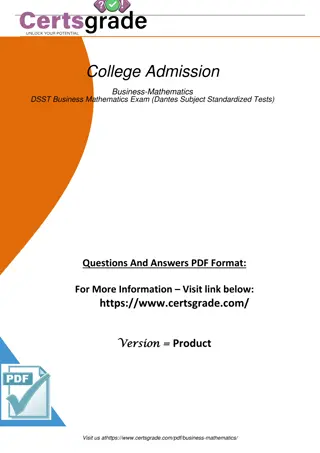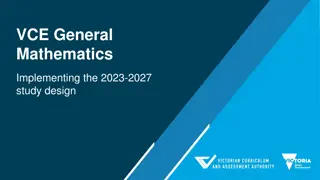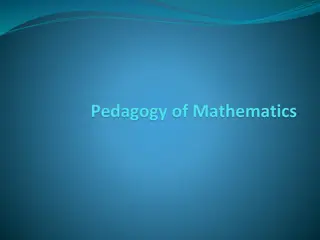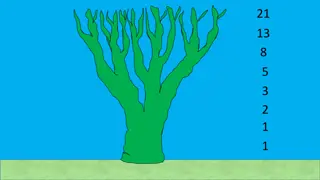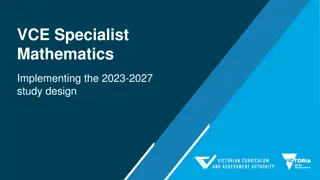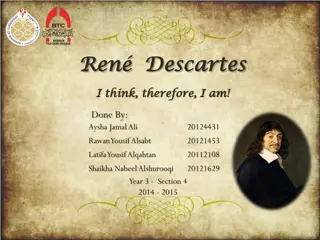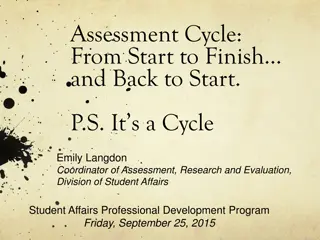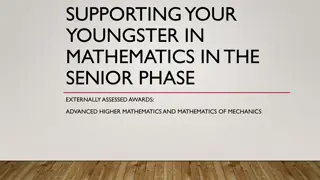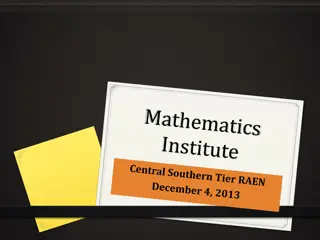Understanding PISA Mathematics Assessment
PISA (Programme for International Student Assessment) evaluates 15-year-old students' preparedness in reading, mathematics, and science literacy. The mathematics assessment focuses on mathematization as a five-stage process, starting from real-world problems to mathematical solutions. The assessment framework includes situational contexts, content, and competencies. Different categories of mathematical problem contexts are explored in the assessment. Through mathematization, students engage with mathematics to become reflective citizens.
Download Presentation

Please find below an Image/Link to download the presentation.
The content on the website is provided AS IS for your information and personal use only. It may not be sold, licensed, or shared on other websites without obtaining consent from the author. Download presentation by click this link. If you encounter any issues during the download, it is possible that the publisher has removed the file from their server.
E N D
Presentation Transcript
PISA MATHEMATICS PRESENTED BY M. S. KUMAR SWAMY TGT(MATHS) KV GACHIBOWLI
PISA PROGRAMME FOR INTERNATIONAL STUDENT ASSESSMENT PISA is a collaborative effort on the part of the member countries of the OECD (Organisation for Economic Co-operation and Development) to measure how well 15-year old students are prepared to meet the challenges of today s knowledge societies. PISA assesses three domains: reading literacy, mathematical literacy, and scientific literacy. HOW PISA WORKS A sample of 15-year-old students is randomly chosen from selected schools in each country for the PISA assessment. PISA is a two-hour pen- and-paper assessment with both multiple- choice questions and questions requiring students to construct their own answers. Students and principals also complete a questionnaire. Each assessment examines one domain in depth, and the other two domains provide a summary profile of skills.
HOW DOES PISA ASSESS MATHEMATICS? PISA mathematical literacy is defined as an individual s capacity to identify and understand the role that mathematics plays in the world, to make well-founded judgements and to engage with mathematics in ways that meet the needs of that individual s life as a constructive, concerned and reflective citizen
According to the PISA mathematics framework (OECD, 2003), mathematisation is a five stage process: 1. starting with a problem situated in a real-world context; 2. organising the problem according to mathematical concepts; 3. gradually trimming away the reality by making assumptions about which features of the problem are important, and then generalising and formalising the problem; 4. solving the mathematical problem; 5. making sense of the mathematical solution in terms of the real situation.
The process of mathematising is illustrated in below Figure (numbers indicate mathematisation described in previous slide). the dimensions of
COMPONENTS OF THE PISA MATHEMATICS FRAMEWORK The PISA mathematics framework has three dimensions: (i) situations and contexts; (ii) content; (iii) and competencies
MATHEMATICS SITUATIONS AND CONTEXTS In PISA, four categories of mathematical problem situations and contexts are used: personal, educational/occupational, public, and scientific. The situation is the part of the student s world in which the problem arises (e.g., a scientific context). Context reflects the specific setting within that situation (e.g., variation in growth rates).
MATHEMATICS CONTENT AREAS PISA measured student performance in four areas of mathematics (also called overarchingideas ): Space & Shape recognising and understanding geometric patterns and identifying such patterns in abstract and real-world representations; Change & Relationships recognising relationships between variables and thinking in terms of and about relationships in a variety of forms including symbolic, algebraic, graphical, tabular, and geometric; Quantity understanding relative size, recognising numerical patterns and using numbers to represent quantities and quantifiable attributes of real-world objects; Uncertainty solving problems relating to data and chance, which correspond to statistics and probability in school mathematics curricula, respectively.
MATHEMATICS COMPETENCIES/PROCESSES PISA identifies eight types of cognitive processes involved in mathematisation reasoning; argumentation; communication; modelling; Problem posing and solving; representation; using symbolic, formal and technical language and operations; and use of aids and tools. A mathematical task may involve one or more of these processes at various levels of complexity. In PISA, these processes are represented at different levels of complexity in three broad competency clusters: Reproduction, Connections, and Reflection.
THE PISA COMPETENCY CLUSTERS REFLECTION CLUSTER assesses students abilities to recognize and extract the mathematics embedded in the situation (to mathematize) use mathematics to solve the problem analyse, interpret, and develop their own models and strategies make mathematical arguments, including proofs and generalizations. REPRODUCTION CLUSTER assesses students knowledge of facts representing, recognizing equivalents recalling mathematical objects & properties performing routine procedures applying standard algorithms developing technical skills CONNECTION CLUSTER assesses students abilities to make connections between the different strands and topics in mathematics integrate information in order to solve simple problems make connections among the different representations decode and interpret symbolic and formal language and understand its relation to natural language
WHAT IS A PISA MATHEMATICS QUESTION LIKE? ITEM TYPES USED IN PISA Different item formats (or types of questions) were used to reflect the variety of ways mathematics can be presented and assessed: Traditional multiple-choice items, in which the student selects a response from among several alternatives. Complex multiple-choice items, in which the student chooses responses for a series of items (e.g., true/false statements, Yes/No). Closed-constructed response items, in which the answer is given in numeric or other form, and can be scored against precisely-defined criteria. Short-response items, in which the student writes a brief answer to a question. Unlike closed-constructed response items, there may be a range of possible correct responses. Open-constructed response items, in which the student provides a longer written response. There is usually a broad range of possible correct responses. Unlike other item types, the scoring of these questions typically requires significant judgement on the part of trained markers.
CARPENTER (SITUATION: EDUCATIONAL) QUESTION 1 A carpenter has 32 metres of timber and wants to make a border around a vegetable patch. He is considering the following designs for the vegetable patch. Circle either Yes or No for each design to indicate whether the vegetable patch can be made with 32 metres of timber.
Vegetable patch design Using this design, can the vegetable patch be made with 32 metres of timber? Design A Design B Design C Design D Yes / No Yes / No Yes / No Yes / No Item type: Complex multiple choice. Process: Connections. Use geometrical insight and argumentation skills, and possibly some technical geometrical knowledge. Answer: Yes, No, Yes, Yes in order
NUMBER CUBES (SITUATION: PERSONAL) On the right, there is a picture of two dice. Dice are special number cubes for which the following rule applies: The total number of dots on two opposite faces is always seven. You can make a simple number cube by cutting, folding and gluing cardboard. This can be done in many ways. QUESTION 1 In the figure below you can see four cuttings that can be used to make cubes, with dots on the sides.
Which of the following shapes can be folded together to form a cube that obeys the rule that the sum of opposite faces is 7? For each shape, circle either Yes or No in the table below. Obeys the rule that the sum of opposite faces is 7? Yes / No Yes / No Yes / No Yes / No Shape I II III IV Item type: Complex multiple choice. Process: Connections. Encode and interpret 2-dimensional objects, interpret the connected 3-dimensional object, and check certain basic computational relations. Answer: No, Yes, Yes, and No, in that order
WALKING (SITUATION: PERSONAL) The picture shows the footprints of a man walking. The pace length P is the distance between the rear of two consecutive footprints. For men, the formula, n/P = 140, gives an approximate relationship between n and P where n = number of steps per minute and P = pace length in metres. QUESTION If the formula applies to Mark s walking and Mark takes 70 steps per minute, what is Mark s pace length? Show your work. Item type: Closed constructed response. Process: Reproduction. Reflect on and realise the embedded mathematics, solve the problem successfully through substitution in a simple formula, and carry out a routine procedure. Answer: 0.5 m or 50 cm
TRIANGLES QUESTION 1 Circle the one figure below that fits the following description: Triangle PQR is a right triangle with the right angle at R. The segment RQ is less than the segment PR. M is the midpoint of the segment PQ, and N is the midpoint of the segment QR. S is a point inside the triangle. The segment MN is greater than the segment MS. Item Type: Open constructed response. Process: Reproduction. Understand a simple problem and implement a simple algorithm correctly. Answer: D.
QUESTION 2 Given that P, Q, and R are the midpoints of the three sides of the ABC respectively. Determine at least one pair of triangles that must be congruent, and justify your decision. Item Type: Open constructed response. Process: Mathematization, mathematical thinking, and the insight would be required. Answer: Naming a correct pair of congruent triangles from the four congruent triangles: APQ PBR QRC PRQ and indicating (in symbols or words) that they are congruent.
EXCHANGE RATE (SITUATION: PUBLIC) Mei-Ling from Singapore was preparing to go to South Africa for 3 months as an exchange student. She needed to change some Singapore dollars (SGD) into South African rand (ZAR). QUESTION 1 Mei-Ling found out that the exchange rate between Singapore dollars and South African rand was: 1 SGD = 4.2 ZAR. Mei-Ling changed 3000 Singapore dollars into South African rand at this exchange rate. How much money in South African rand did Mei-Ling get? Item Type: Closed constructed response. Process: Reproduction. Understand a simple problem and implement a simple algorithm correctly. Answer: 12600 ZAR QUESTION 2 On returning to Singapore after 3 months, Mei-Ling had 3 900 ZAR left. She changed this back to Singapore dollars, noting that the exchange rate had changed to: 1 SGD = 4.0 ZAR. How much money in Singapore dollars did Mei-Ling get? Item Type: Closed constructed response. Process: Reproduction. Understand a simple problem and implement a simple algorithm correctly (in reverse). Answer: 975 SGD
QUESTION 3 During these 3 months the exchange rate had changed from 4.2 to 4.0 ZAR per SGD. Was it in Mei-Ling s favour that the exchange rate now was 4.0 ZAR instead of 4.2 ZAR, when she changed her South African rand back to Singapore dollars? Give an explanation to support your answer. Item type: Open constructed response. Process: Reflection. Identify the relevant mathematics, reduce the task to a problem within the mathematical world, and construct an explanation of the conclusion. Answer: Yes, because she received 4.2 ZAR for 1 SGD, and now she has to pay only 4.0 ZAR to get 1 SGD
SKATEBOARD (SITUATION: PERSONAL) Eric is a great skateboard fan. He visits a shop called SKATERS to check some prices. At this shop you can buy a complete board. Or you can buy a deck, a set of 4 wheels, a set of 2 trucks and a set of hardware, and assemble your own board. The prices for the shop s products are: Product Price in zeds 82 or 84 40, 60 or 65 14 or 36 16 Complete skateboard Deck One set of 4 Wheels One set of 2 Trucks One set of hardware (bearings, rubber pads, bolts and nuts) 10 or 20 QUESTION 1 Eric wants to assemble his own skateboard. What is the minimum price and the maximum price in this shop for self-assembled skateboards? (a) Minimum price: _______________ zeds. (b) Maximum price: _______________ zeds. Item type: Closed constructed response. Process: Reproduction. Interpret a simple table, find a simple strategy to come up with the maximum and minimum, and use of a routine addition procedure. Answer: minimum (80) and maximum (137)
QUESTION 2 The shop offers three different decks, two different sets of wheels and two different sets of hardware. There is only one choice for a set of trucks. How many different skateboards can Eric construct? A 6 B 8 C 10 D 12 Item type: Traditional multiple choice. Process: Reproduction. Interpret a text in combination with a table; apply a simple enumeration algorithm accurately. Answer: D
1st deck 2nd deck 3rd deck 1st Wheel 2nd Wheel 1st Hardware 2nd Hardware
EARTHQUAKE (SITUATION: SCIENTIFIC) A documentary was broadcast about earthquakes and how often earthquakes occur. It included a discussion about the predictability of earthquakes. A geologist stated: In the next twenty years, the chance that an earthquake will occur in Zed City is two out of three. QUESTION 1 Which of the following best reflects the meaning of the geologist s statement? A. 20 = 13.3, so between 13 and 14 years from now there will be an earthquake in Zed City. B. is more than , so you can be sure there will be an earthquake in Zed City at some time during the next 20 years. C. The likelihood that there will be an earthquake in Zed City at some time during the next 20 years is higher than the likelihood of no earthquake. D. You cannot tell what will happen, because nobody can be sure when an earthquake will occur. Item type: Traditional multiple choice Process: Reflection. Identify the relevant mathematics, and select the conclusion that reflects the meaning of a statement of probability. Answer: C
YOUTH GROWS TALLER In 1998 the average height of both young males and young females in the Netherlands is represented in this graph.
QUESTION 1 Since 1980 the average height of 20-year-old females has increased by 2.3 cm, to 170.6 cm. What was the average height of a 20-year-old female in 1980? Answer: ..................................................cm Item type: Closed constructed response. Process: Reproduction. Understand a simple problem and implement a simple algorithm correctly. Answer: 168.3 cm QUESTION 2 According to this graph, on average, during which period in their life are females taller than males of the same age? .......................................................................................................................... Item type: Short response. Process: Reproduction. Understand a simple problem and implement a simple algorithm correctly. Answer: during 11-13 years
QUESTION 3: Explain how the graph shows that on average the growth rate for girls slows down after 12 years of age. ........................................................................................................... Item type: Open constructed response. Process: Reflection. Identify the relevant mathematics, reduce the task to a problem within the mathematical world, and construct an explanation of the conclusion. Answer: Three ways Refers to the reduced steepness of the curve from 12 years onwards, using daily-life language, not mathematical language. It does no longer go straight up, it straightens out. The curve levels off. It is more flat after 12. Refers to the reduced steepness of the curve from 12 years onwards, using mathematical language. You can see the slope/gradient is less. The rate of change of the graph decreases from 12 years on. In general, if words like gradient , slope , or rate of change are used, regard it as using mathematical language. Comparing actual growth . From 10 to 12 the growth is about 15 cm, but from 12 to 20 the growth is only about 17 cm. The average growth rate from 10 to 12 is about 7.5 cm per year, but about 2 cm per year from 12 to 20 years.
SPEED OF RACING CAR This graph shows how the speed of a racing car varies along a flat 3 kilometre track during its second lap. QUESTION 1 What is the approximate distance from the starting line to the beginning of the longest straight section of the track? A 0.5 km B 1.5 km C 2.3 km D 2.6 km Item type: Traditional multiple choice. Process: Connections and integration for problem solving Answer: B. 1.5 km
QUESTION 2 Where was the lowest speed recorded during the second lap? A. at the starting line. B. at about 0.8 km. C. at about 1.3 km. D. halfway around the track. Item type: Traditional multiple choice. Process: Reproduction. Interpret graph, find a simple strategy to come up with the correct distance. Answer: C. at about 1.3 km. QUESTION 3 What can you say about the speed of the car between the 2.6 km and 2.8 km marks? A. The speed of the car remains constant. B. The speed of the car is increasing. C. The speed of the car is decreasing. D. The speed of the car cannot be determined from the graph. Item type: Traditional multiple choice. Process: Reproduction. Interpret graph, find a simple strategy to come up with the correct change in the speed. Answer: B. The speed of the car is increasing.
QUESTION 4 Here are pictures of five tracks: Along which one of these tracks was the car driven to produce the speed graph shown earlier? Item type: Open constructed response. Process: Connections and integration for problem solving Answer: B
COINS You are asked to design a new set of coins. All coins will be circular and coloured silver, but of different diameters. Researchers have found out that an ideal coin system meets the following requirements: diameters of coins should not be smaller than 15 mm and not be larger than 45 mm. given a coin, the diameter of the next coin must be at least 30% larger. the minting machinery can only produce coins with diameters of a whole number of millimetres (e.g. 17 mm is allowed, 17.3 mm is not).
QUESTION You are asked to design a set of coins that satisfy the above requirements. You should start with a 15 mm coin and your set should contain as many coins as possible. What would be the diameters of the coins in your set? Item type: Closed constructed response. Process: Reproduction, understanding and use of complicated information to do calculations. Answer: 15 20 26 34 45. 30% of 15 = 4.5 then 15 + 4.5 = 19.5 approximately equal to 20 30% of 20 = 6 then 20 + 6 = 26 30% of 26 = 7.8 then 26 + 7.8 = 33.8 approximately equal to 34 30% of 34 = 10.2 then 34 + 10.2 = 44.2 approximately equal to 45 (according to the question for 44.2, 45 is allowed)



